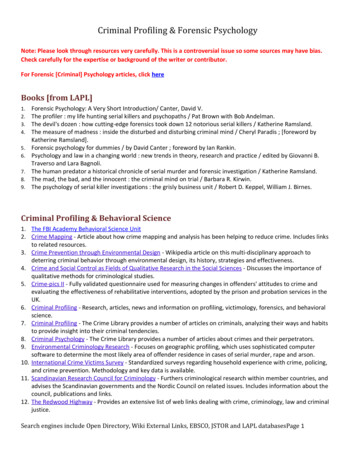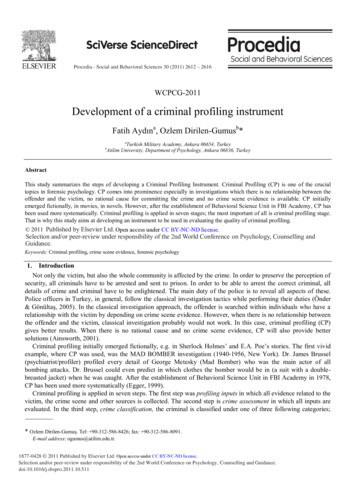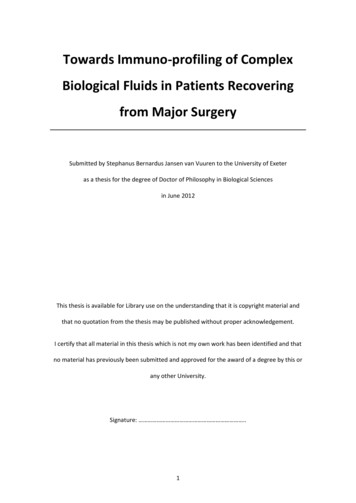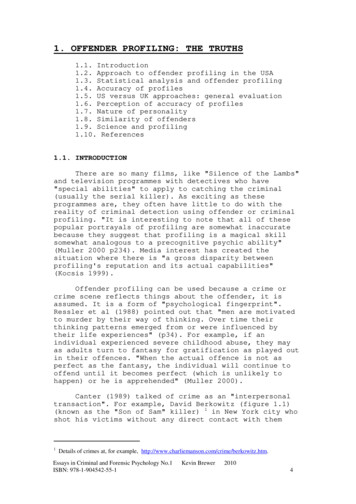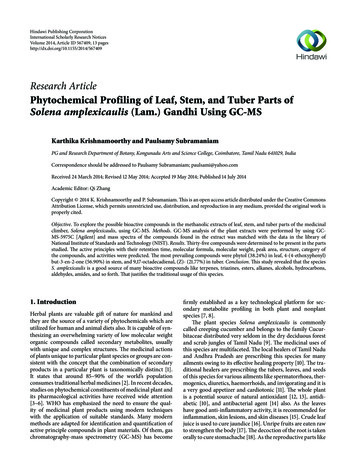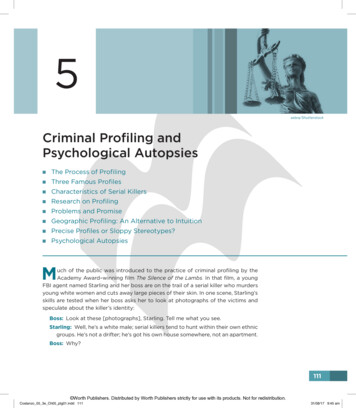
Transcription
1115sebra/ShutterstockCriminal Profiling andPsychological Autopsies The Process of Profiling Three Famous Profiles Characteristics of Serial Killers Research on Profiling Problems and Promise Geographic Profiling: An Alternative to Intuition Precise Profiles or Sloppy Stereotypes? Psychological AutopsiesMuch of the public was introduced to the practice of criminal profiling by theAcademy Award–winning film The Silence of the Lambs. In that film, a youngFBI agent named Starling and her boss are on the trail of a serial killer who murdersyoung white women and cuts away large pieces of their skin. In one scene, Starling’sskills are tested when her boss asks her to look at photographs of the victims andspeculate about the killer’s identity:Boss: Look at these [photographs], Starling. Tell me what you see.Starling: Well, he’s a white male; serial killers tend to hunt within their own ethnicgroups. He’s not a drifter; he’s got his own house somewhere, not an apartment.Boss: Why?111 Worth Publishers. Distributed by Worth Publishers strictly for use with its products. Not for redistribution.Costanzo 05 3e Ch05 ptg01.indd 11131/08/17 9:45 am
112Chapter 5Criminal Profiling and Psychological AutopsiesStarling: What he does with them takes privacy. He’s in his thirties or forties.He’s got real physical strength, combined with an older man’s self-control. He’scautious, precise. He’s never impulsive; he’ll never stop.Boss: Why not?Starling: He’s got a real taste for it now; he’s getting better at his work.Boss: Not bad, Starling.Starling’s impromptu profile of the killer turns out to be dead-on. But of course,she’s a fictional character, and The Silence of the Lambs is only a movie. Is it reallypossible to make valid inferences about a criminal’s age, race, gender, living circumstances, and personality based only on information from a crime scene?The Process of ProfilingProfiling is the process of drawing inferences about a criminal’s personality,behavior, motivation, and demographic characteristics based on crime scenes andother evidence. The techniques of criminal profiling were pioneered by the FBI’sBehavioral Science Unit (BSU) and have been used in the United States, Canada, theUnited Kingdom, Sweden, Finland, Germany, and the Netherlands (Bartol & Bartol,2013). Profiling techniques have been most famously applied to cases involvingserial killers—murderers who kill three or more people in separate events with acooling-off period between murders. Since developing these profiling techniques,the FBI has trained thousands of law enforcement officers in their use.To create a tentative description—or profile—of the criminal, profilers analyzethe crime scenes, gather information about the victims, and study both policeand autopsy reports. Profiles provide leads for police and help focus the effortsof investigators. For example, officers might be told to look for a white male in his20s who works nights and lives in a particular part of a city. A profile might alsobe used to set a trap for the criminal. For example, if police are looking for a serialkiller who preys on young prostitutes with long dark hair, an officer with longdark hair may pose as a prostitute in an effort to attract and entrap the killer. Ineffect, a profile instructs investigators to look for a particular type of person andto ignore other types of people. A profile may also suggest questions to ask andtopics to explore when questioning suspects.Profilers emphasize the importance of the signature aspect of the crime—the distinctive, personal feature of the crime (e.g., a particular form of tortureor a particular sexual activity) that presumably reveals the killer’s personality.According to John Douglas, one of the agents who developed the FBI’s system,the methods used to abduct, transport, or dispose of victims may change, but thesignature will remain relatively constant because it is “why he does it: the thingthat fulfills him emotionally . . . the emotional reason he’s committing the crimein the first place” (Douglas & Olshaker, 1997, p. 26). Worth Publishers. Distributed by Worth Publishers strictly for use with its products. Not for redistribution.Costanzo 05 3e Ch05 ptg01.indd 11225/08/17 3:37 pm
The Process of Profiling113Although the profiling of serial killers has captured the imagination ofHollywood and the general public, it remains a largely unvalidated technique.The process requires a series of inferential leaps that can be succinctly summarized as moving from “what?” to “why?” to “who?” (Pinizzotto & Finkel, 1990).That is, by closely examining the crime and the victims, the profiler is presumablyable to reach conclusions about why the killer committed the crime. An understanding of why then leads to inferences about the perpetrator’s characteristicsand identity. Unfortunately, how profilers move from raw data about a crimeto a useful profile of the criminal is neither systematic nor clearly articulated.According to Douglas:The key attribute necessary to be a good profiler is judgment—a judgmentbased not primarily on the analysis of facts and figures, but on instinct. . . .and ultimately, it comes down to the individual analyst’s judgment ratherthan any objective scale or test. ( Douglas & Olshaker, 1997, p. 15)He further explains thatit’s very important to get into the mind of not only the killer, but into themind of the victim at the time the crime occurred. That’s the only way you’regoing to be able to understand the dynamics of the crime—what was goingon between the victim and the offender. (p. 17)Indeed, much of the mystique of the profiling process is that it appears to relyon the skilled intuition of a particular profiler. In movie and television depictions of the technique, profilers seem to be as much psychics as investigators.They often enter a trancelike state that allows them to inhabit the mind of aserial killer, to imagine what the killer saw and felt at the time of the killing. AsDouglas writes:What I try to do is to take in all the evidence I have to work with . . . then putmyself mentally and emotionally in the head of the offender. I try to thinkas he does. Exactly how this happens, I’m not sure. . . . If there’s a psychiccomponent to this, I won’t run from it. ( Douglas & Olshaker, 1997, p. 147 )In literary and media portrayals, the profiler–hero arrives at the scene of astalled murder investigation, immerses himself or herself in the details ofgruesome crimes, and uses mysterious psychological methods to infiltrate themind and motivations of the killer. Empowered by the profiler’s special insights,investigators capture the killer (Gregoriou, 2011). Many first-person accountsof profiling written by former FBI agents also follow a formula: a narrative ofthe case to be solved, a description of the profile developed by the FBI to assistinvestigators, a comparison of the characteristics of the actual killer with theprofile, and a claim of astonishing accuracy (Risinger & Loop, 2002). But stories and case studies do not constitute real evidence of effectiveness. Systematicresearch is required to demonstrate the usefulness of profiling or any other technique. This chapter describes several actual criminal profiles and summarizesresearch on the effectiveness of profiling. Worth Publishers. Distributed by Worth Publishers strictly for use with its products. Not for redistribution.Costanzo 05 3e Ch05 ptg01.indd 11325/08/17 3:37 pm
114Chapter 5Criminal Profiling and Psychological AutopsiesThree Famous ProfilesJack the RipperIn 1888, Dr. Thomas Bond formulated what might be considered the firstcriminal profile (Rumbelow, 1975). In that year, “Jack the Ripper” terrorizedthe East End of London, strangling and slitting the throats of at least fiveprostitutes (the exact number is a matter of some controversy). The murderswere daring and gruesome: The women were attacked and killed on publicstreets, their bodies were mutilated, and in some cases, internal organs wereremoved and taken from the crime scene. The still-warm corpses were discovered lying in the streets soon after the ripper had fled the scene. Dr. Bondperformed autopsies on two of the victims. Here are his speculations aboutthe physical and psychological characteristics of the ripper based on thecharacteristics of the crimes (we have added the likely bases for these speculations in parentheses): “A man of great physical strength.” (He managed to swiftly subdue his victims;none were able to escape or successfully call out for help.)“A man of great coolness and daring.” (His savage crimes were committedefficiently and in public spaces where they could have been witnessed by passersby.)“The murderer in external appearance is quite likely to be a quiet, inoffensivelooking man probably middle-aged and neatly and respectably dressed.” (Hemanaged to enter and exit the crime scene without detection, so he apparently blendedin and did not call attention to himself.)“He must be in the habit of wearing a cloak or overcoat.” (It would have beenimpossible to kill and mutilate his victims swiftly without getting blood on his handsand clothes, and a large cloak or coat would hide the blood.)“[S]olitary and eccentric in his habits, also he is most likely to be a man without regular occupation.” (Someone capable of such depravity would have difficultyinteracting with others without raising suspicion or discomfort.)Unfortunately, Jack the Ripper was never caught, so we cannot assess the accuracy of Bond’s pioneering profile. However, it appears to be the first systematicprofile offered to assist police in a criminal investigation.The Olympic BomberAlthough profiling has been most famously applied to cases involving serialkillers, profiling techniques have been used—with varying levels of success—in the investigation of many other types of crimes, including rape, arson, skyjacking, and bombing. One notorious profile was produced in response to abomb explosion during the 1996 Summer Olympics in Atlanta, Georgia. Basedon evidence uncovered at the scene of the bombing and on their databaseof past bombings at public events, the FBI instructed police to search for asingle, white, middle-class male with an intense interest in police work andlaw enforcement (the kind of person investigators sometimes call a “policebuff” or “cop wannabe”). Within days, the police focused their attention on Worth Publishers. Distributed by Worth Publishers strictly for use with its products. Not for redistribution.Costanzo 05 3e Ch05 ptg01.indd 11425/08/17 3:37 pm
115Three Famous ProfilesRichard Jewell, a security guard at the Olympic Park who fit the profile inevery respect. Jewell became the target of intense investigation. Because ofthe need to reassure people that the Olympic venues were safe, Jewell’s nameand photograph appeared in newspapers across the country, and his facewas shown on television news programs in several countries. It appearedthat the bomber had been caught.Only after three months—long after the Olympics had ended—did theFBI admit that investigators had uncovered no evidence linking Jewell tothe bombing. Of course, the damage to Jewell’s life and reputation could notbe easily undone. In 1998, after much additional investigation, the FBI finallycharged another man—Eric Rudolph—with the Olympic bombing. Rudolphwas an antiabortion activist who was wanted in connection with the bombingof abortion clinics in two states (Sack, 1998). He evaded police for several yearsbut was finally captured and convicted of the bombing in 2005.The Mad BomberOne of the most famous profiles ever produced was also one of the most detailed.It was used to help solve the “Mad Bomber” case in 1957. In 1940, an unexplodedbomb was found on a windowsill of the building occupied by the ConsolidatedEdison Company. The note attached to the bomb explained: “Con Edison crooks,this is for you.” The perpetrator, who became known as the Mad Bomber, managed to terrorize the public by successfully planting (and sometimes detonating)bombs in locations dispersed across New York City (Ramsland, 2013). He sentseveral letters and placed a few phone calls to the New York City Police Department and The New York Times. Just after the United States entered World War IIin 1941, the Mad Bomber sent a letter to the police declaring that because of his“patriotic feelings,” he would “make no more bomb units for the duration of thewar” (Brussel, 1968, p. 21). He was true to his word. No more bombs were founduntil 1951. But in the same letter that informed police that his patriotism hadinspired him to suspend bombings, he also declared that he would later return to“bring Con Edison to justice” and make them “pay for their dastardly deeds”(Brussel, 1968, p. 23). Indeed, he planted several more bombs over the years1951–1956.Police were baffled. In 1956, in a desperate attempt to generate new leads, theyconsulted Dr. James Brussel, a prominent local psychiatrist. Brussel reviewedthe bomber’s letters, as well as all the other information the police had collected,and directed the police to look for a man who was between 40 and 50, RomanCatholic, foreign born, single, and living with a brother or sister. He would besuffering from progressive paranoia and would be a “present or former Consolidated Edison worker.” In an especially precise but odd detail, Brussel toldpolice: “When you find him, chances are he’ll be wearing a double-breastedsuit. Buttoned” (Brussel, 1968, p. 47). The man the police eventually arrested—George Metesky—was a single, unemployed, 54-year-old former employee ofCon Ed who was living with two older sisters. When the police took him intocustody, he was allowed to go into his room and change from his bathrobe. Heemerged from his room wearing a double-breasted blue suit—buttoned.Eric Rudolph (the Olympicbomber). (AP Photo/CherokeeCounty Sheriff’s Dept.)George Metesky (the“Mad Bomber”). (JuddMehlman/NY Daily News Archivevia Getty Images) W
charged another man—Eric Rudolph—with the Olympic bombing. Rudolph was an antiabortion activist who was wanted in connection with the bombing of abortion clinics in two states (Sack, 1998). He evaded police for several years but was finally captured and convicted of the bombing in 2005. The Mad Bomber

